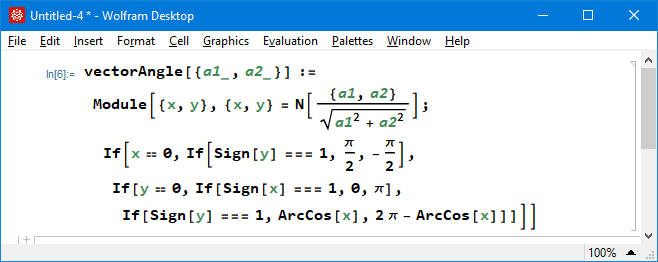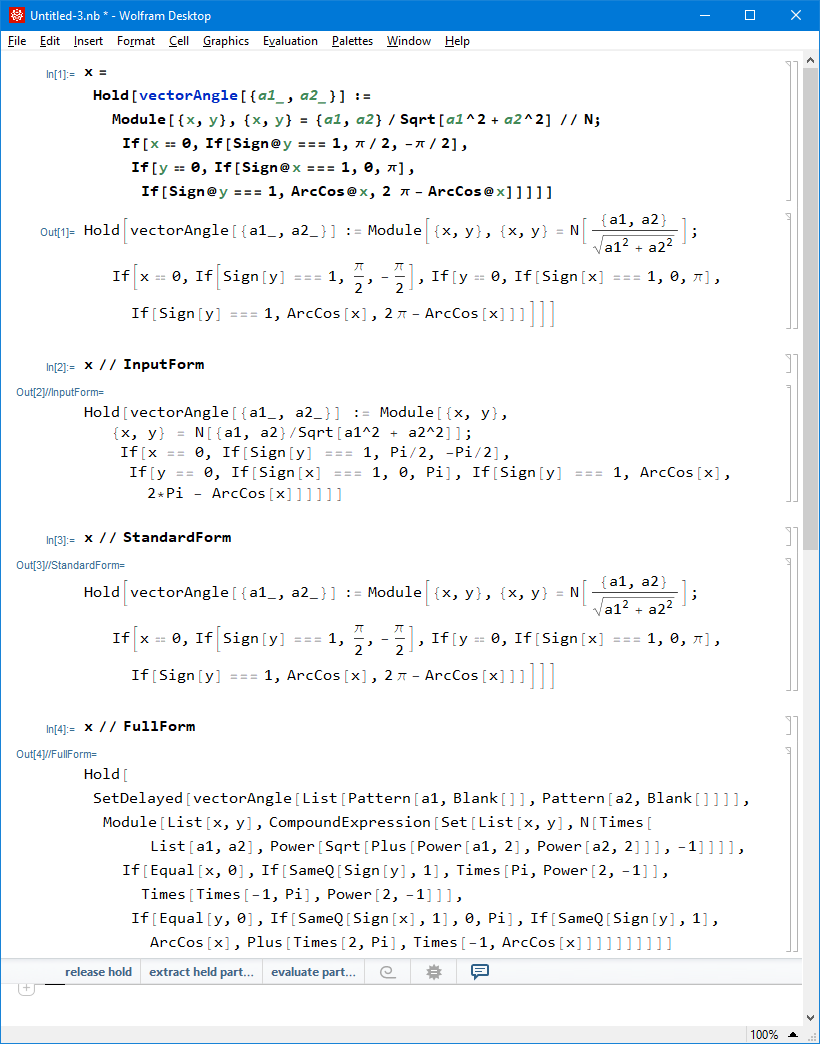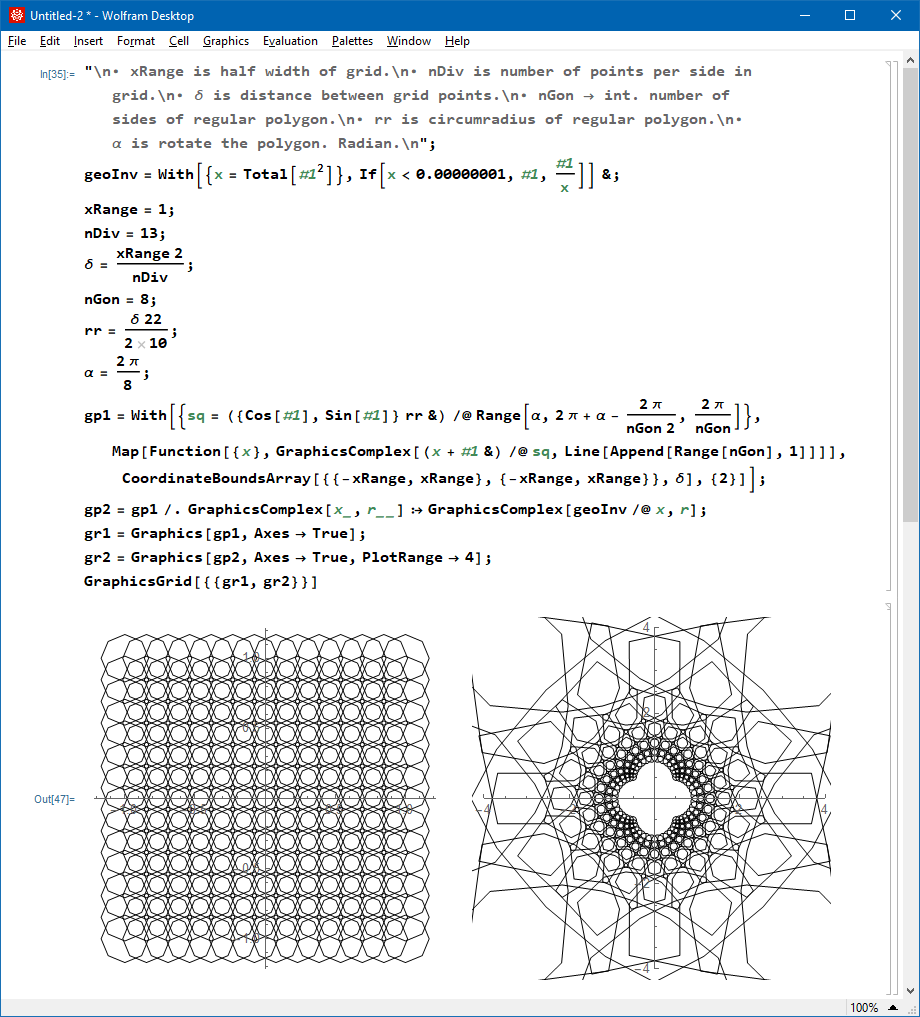Syntax: Wolfram Language vs Lisp (2013)
WolframLang syntax and lisp syntax are isomorphic. WolframLang syntax has this form in general:
e0[e1, e2, e3]
while lisp is
(e0 e1 e2 e3)
Symbolic Expression
Here is a example of WolframLang syntax in FullForm.
SetDelayed[vectorAngle[List[Pattern[a1,Blank[]],Pattern[a2,Blank[]]]], Module[List[x,y], CompoundExpression[ Set[List[x,y], N[Times[List[a1,a2], Power[Sqrt[Plus[Power[a1,2],Power[a2,2]]],-1]]]], If[Equal[x,0], If[SameQ[Sign[y],1],Times[Pi,Power[2,-1]], Times[Times[-1,Pi],Power[2,-1]]], If[Equal[y,0],If[SameQ[Sign[x],1],0,Pi], If[SameQ[Sign[y],1],ArcCos[x], Plus[Times[2,Pi],Times[-1,ArcCos[x]]]]]]]]]
Note the complete nested regularity F[…].
And the only character used are English alphabets, the square brackts, and comma.
The whole language is just these character, corresponding to lisp's parenthesis and space.
Here is the same thing in lisp form. (called symbolic-expression (aka s-exp))
(SetDelayed (vectorAngle (list (Pattern a1 (Blank)) (Pattern a2 (Blank)))) (let (list x y) (progn (setq (list x y) (N (* (list a1 a2) (exp (sqrt (+ (exp a1 2) (exp a2 2))) -1)))) (if (eq x 0) (if (equal (signum y) 1) (* Pi (exp 2 -1)) (* (* -1 Pi) (exp 2 -1))) (if (eq y 0) (if (equal (signum x) 1) 0 Pi) (if (equal (signum y) 1) (acos x) (+ (* 2 Pi) (* -1 (acos x)))))))))
Meta Expression
Following is the same thing in WolframLang InputForm. (which is a syntax layer on top of the regular nested form. Such is known as meta-expression (aka m-exp) in lisp world, conceived by lisp inventor John McCarthy, but never caught on in lisp comunity.)
vectorAngle[{a1_, a2_}] := Module[{x, y}, {x, y} = {a1, a2}/Sqrt[a1^2 + a2^2] // N; If[x == 0, If[Sign@y === 1, Pi/2, -Pi/2], If[y == 0, If[Sign@x === 1, 0, Pi], If[Sign@y === 1, ArcCos@x, 2 Pi - ArcCos@x]]]]
Note the vectorAngle[{a1_, a2_}] := …? That's your lisp macros, but in a advanced form, called pattern matching. The “a1_” and “a2_” are patterns, and the right-hand-side is the transformation spec. 〔see Intro to Wolfram Language Pattern Matching for Lisp Coders (2008)〕
StandardForm (rendered display)
Following is the same thing rendered in WolframLang StandardForm.



See also:
- Concepts and Confusions of Prefix, Infix, Postfix and Lisp Notations (2006)
- Wolfram: Syntax Shortcuts and Operators
- Nested Syntax: XML vs LISP (2013)
- LISP Infix Syntax Survey (2013)
- Fundamental Problems of Lisp, Syntax Irregularity (2008)
- Is XML Inferior Version of Lisp Syntax (2012)
- Comp Lang: LISP Syntax Problem of Chaining Functions
- Systematic Syntax: Lisp vs Mathematica
- Lisp vs Perl Syntax, the Cult Problem
- Why Lisp Macro Sucks
- Famous Programers on How Common Lisp Sucks (2012)
- History of LISP UNIX vi from “Worse Is Better” (2011)
- LISP is Not Functional
- Elisp: read-from-minibuffer Propels Deep Questions
- Docstring Convention: Python vs Emacs Lisp
- Programing Language: Which One Allows Unicode Math Symbols in Function Name and Operator